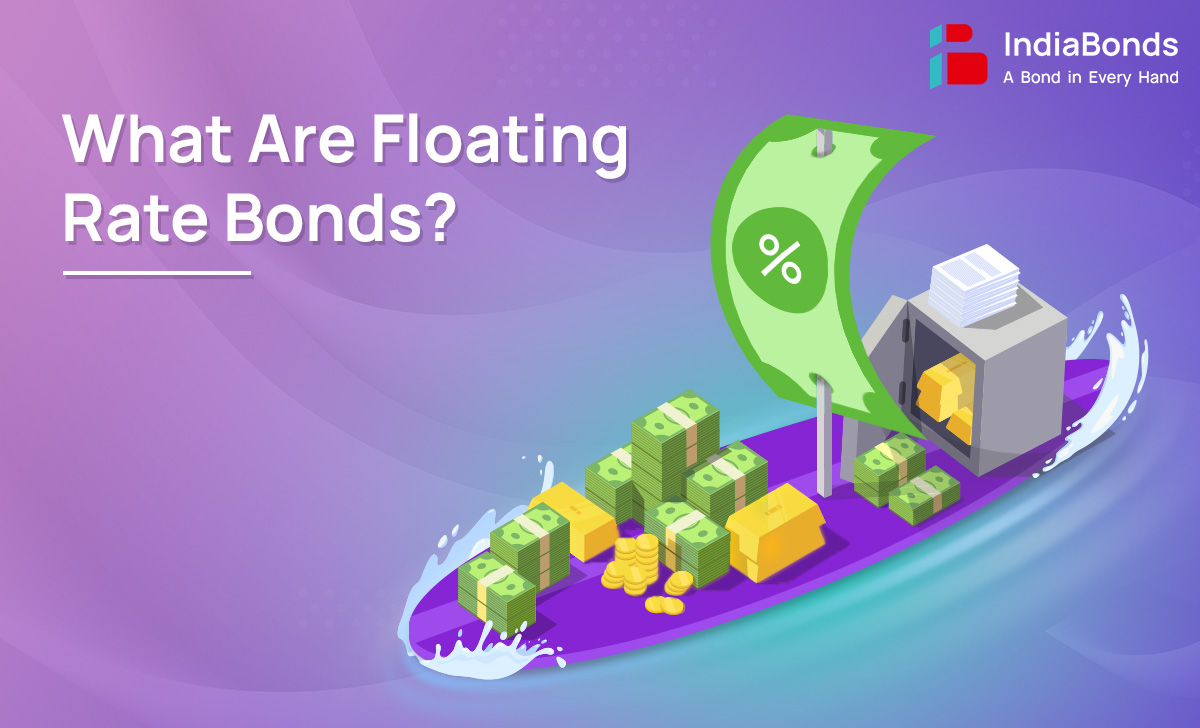What Are Floating Rate Bonds?

Bonds are debt instruments that loan money to their issuers. It is a type of borrowing where the issuer borrows funds at an interest rate that is either fixed or variable. A government, a bank, or a corporation may issue a bond. Bonds can be issued either at fixed rates or at floating rates. Here, you will learn what is a floating rate bond, it’s advantages, limitations, and how they work.
What are Floating Rate Bonds (FRBs)?
Floating rate bonds have variable coupon payments, meaning interest rates fluctuate regularly based on a benchmark rate reset. A floating rate bond has an interest rate that fluctuates throughout its tenure due to the changes in underlying benchmark interest rate. Floating rate bonds can be priced over different benchmarks in India with most popular being government issued bonds or T-Bills. Other benchmarks that are used include RBI repo rate or SBI prime lending rate, please note that internationally the much popular reference benchmark LIBOR (London Interbank Offer Rate) has being phased out and replaced by SOFR (Secured Overnight Financing Rate).
Most companies, government agencies, and financial institutions issue these bonds to borrow funds from the public. Following the bond terms, these bonds pay interest quarterly, half-yearly, or annually. Additionally, interest rates are reset periodically according to coupon payments.
An easy way to understand a floating-rate bond is to compare it to a floating-rate mortgage. Your interest rate (and EMI) will increase when repo rates rise. The coupon rates of floating-rate bonds also give you higher returns when repo rate rises. (Considering repo rate is the benchmark for home loan and Bonds)




How Do Floating Rate Bonds Work?
Regular fixed-rate bonds experience a decrease in bond prices when interest rates rise, reflecting an increase in bond yields. Compared to these, floating-rate bonds have coupons that fluctuate following the market rates at any given moment. Hence, whenever interest rates rise, proportionately the coupon of the bonds rises restricting the fall of the price of that particular bond.
In this way, the investor can obtain better returns. A drop in interest rates will also result in coupon rates falling, thus reducing an investor’s yield. Investors should invest in these bonds when there is low interest rate environment or interest rates are expected to rise in future. When investing in these floating rate bonds, investors cannot predict their cashflow as coupons are subject to market fluctuations.
What are the Different Classifications of a Floating Rate Bond?
There are two main types of floating rate bonds:
Callable Floating Rate Bonds:
An issuer of a callable floating-rate bond can call back the bond at any time. The issuer stops paying interest when the bondholder has repaid the principal amount. Bonds with floating rates allow the issuer to retire the bonds before maturity if interest rates rise a lot.
Non-callable Floating Rate Bonds
Floating rate savings bonds do not allow the issuer to call them back or retire them before maturity. It doesn’t matter if the issuer incurs a loss after paying the interest for such bonds, as the interest rate is determined from the underlying benchmark.
Advantages and Disadvantages of Floating rate bonds
The flexibility of floating-rate bonds makes them attractive to investors. When the benchmark interest rate rises, so do the interest rate on the floating rate bond.
Advantages
Less Volatility:
A floating-rate bond has less exposure to volatility or negative price movements because it can adjust to market interest rates. On the other hand, fixed rate bonds fall in price when interest rates go higher and vice versa.
Safe Investments:
Mostly floating rate bonds are issued by Government or its entities. These are relatively much safer than other issuers and are a good option for investors. They also use government rates as benchmark which are more transparent and market driven.
Diversification:
In times of low-interest rates and projected increase in interest rates, floating-rate bonds are a great way to diversify assets. As interest rates rise, so will the amount of interest payable, while the principal remains the same.
Matching Costs with Income:
Most individual investors have regular payments as EMIs for house mortgage, vehicle purchase or other forms of bank loans. All of these are usually tied to variable interest rates and their payment costs rise with interest rates. Having floating rate bonds in your portfolio helps you to hedge better as you also receive higher payments that offset rising costs.
Example of a Floating Rate Bond
Let’s look at an example of floating rate bonds where the coupon rate is adjusted on the basis of the movement of benchmark repo rate:
A bond of XYZ Ltd. (corporate bond) is issued at:
Coupon/interest rate – 7%
Benchmark – (Repo rate) – 5%
Mark-up – 200bps or 2% over the benchmark rate
Rate adjustment period – 6 months
Thus, a floating rate bond will have an interest/coupon rate of 5.00% + 2.00% = 7.00%.
After 6 months, if the repo rate rises up to 5.50% The same corporate bond interest/coupon rate will be 5.50% + 2.00% = 7.50% as the mark-up remains constant.
What is the Role of Floating-Rate Bonds in a Portfolio?
Floating-rate bonds play a crucial role in an investment portfolio, particularly in a fluctuating interest rate environment. Here are some key roles they serve:
Hedge Against Interest Rate Risk
Floating rate bonds help mitigate interest rate risk. As interest rates rise, the coupon payments on these bonds also increase, providing a natural hedge against falling prices of fixed-rate bonds.
Income Stability in Rising Rate Environments
For investors concerned about income erosion due to rising interest rates, floating rate bonds offer a more stable income stream. This can be particularly beneficial for retirees or income-focused investors.
Portfolio Diversification
Including floating rate bonds in a portfolio diversifies the interest rate exposure. This diversification can reduce the overall volatility of the portfolio and enhance risk-adjusted returns.
Matching Liabilities
Investors with liabilities tied to variable interest rates, such as adjustable-rate mortgages, can match these liabilities with floating rate bonds. This alignment helps manage cash flow more effectively, as the increase in interest income from the bonds can offset the higher interest expenses on the liabilities.
Opportunity in Rising Rate Cycles
In periods where interest rates are expected to rise, floating rate bonds become particularly attractive. They allow investors to benefit from the increasing rates without the price volatility associated with fixed-rate bonds.
How to Invest in Floating Rate Bonds in India?
Governments, corporations, and financial institutions can issue floating-rate bonds in India. The primary and secondary markets are options for investing in these bonds. A variety of options are available for investing in floating-rate bonds in India.
Investing in Floating Rate Bonds in India is quite simple when you decide to invest through IndiaBonds. Invest online in 3 simple steps
1. Sign up on https://www.indiabonds.com/. Stay updated on the latest bond issuances.
2. Complete your online KYC in under 3 minutes. It’s paperless and requires no uploads
3. Select from a variety of bonds and invest online. In case of queries, IndiaBonds Bond managers will guide you through the process.
To invest through the primary market by means of Bond Public Issues, browse through the bond offerings on our Public Issue Page. Initiate your Bond investment process by clicking on “Apply Now”. You can make payments online through UPI for amounts upto INR 5 Lakhs and via ASBA for amounts exceeding INR 5 Lakhs.
To invest in the secondary market through the stock exchange, visit the “Explore” Page and choose from a wide variety of bonds that are available for investing. Choose the bond of your choice and continue with the bond investment process.
In case you are looking to invest in a specific bond you can find the details for the same on Bond Directory – India’s first private Bond repository that lists over 25,000 bond details all under one roof.
Conclusion
If you think the market interest rate will begin to rise sooner rather than later, floating-rate bonds are an excellent way to realize a high amount of interest. Although floating-rate bonds in India are also subject to some risks. Having gained a better understanding of floating-rate bonds, you may consider purchasing floating-rate bonds to diversify your portfolio.
FAQs
Q. What is the difference between a floating rate and fixed rate bond?
A. Floating rate bonds have variable interest payments that adjust periodically based on a benchmark rate, while fixed rate bonds have a constant interest payment throughout the bond’s tenure.
Q. Is RBI floating rate bond tax free?
A. No, the interest earned on RBI floating rate bonds is taxable. The interest income is added to the investor’s total income and taxed according to their applicable income tax slab.
Q. What is a floating rate bond structure?
A. A floating rate bond structure includes a variable coupon rate that resets periodically based on a benchmark interest rate, such as the repo rate or a government bond yield. The bond may also have a fixed mark-up over the benchmark rate, and the reset frequency (e.g., every six months) defines how often the interest rate is adjusted.
Disclaimer: Investments in debt securities/ municipal debt securities/ securitised debt instruments are subject to risks including delay and/ or default in payment. Read all the offer related documents carefully.
















































